Info panel extensions
Overview
Since WEBCON BPS 2023 R1 it is possible to Assigning tasks to groups instead of assigning the tasks to the members directly. This has the benefit that any added group member can see the existing tasks.
This was not the case when the tasks have been assigned directly to the group members before. While this is a great improvement, it also has a little drawback. Others may not necessarily know who’s part of the group. Therefore, I was asked, whether we could show who’s a member of a group, when the mouse is over the group name. Based on my past experiences I replied with “Yes” without thinking about it at all. Luckily, it was actually really easy, at least for me. I ‘just’ needed to put different stuff together and I also signed up for the GitHub Copilot trial to test it a bit.
Implementation
Overview
I already created two features which modified the details tab of the info panel:
Instead of creating a third one I decided to merge those and the new functionality together into one with. The functionalities can then be selected for a given process.
Therefore, I will also merge the implementation / configuration details here. I will skip most of the explanations for the ‘Start Teams chat’ and ‘Custom user icon’ feature. You can refer to the old posts for these.
We need:
- Global business rules If you don’t intend to a specific functionality, you can skip the creation of the necessary business rule.
- Global form rule
- HTML field
- Global css
Remark: The global business rule for the ‘New task’ has changed slightly because I wanted it to align to the other business rule. If you already have this one in your system you need to update it.
Global business rule
Custom user icon
WEBCON BPS already takes care of the problem, whether a user viewed a task or not. If the user didn’t view it, the task panel will display it in the New tab.

New and My (viewed) tasks.
This makes it quite easy for us, as we only need to create a business rule with a SQL command.
Rule name: GetNewTasksIds
Description: Return a comma separated list of those tasks ids, which haven't been displayed to a user.
SELECT '[' + isnull(STRING_AGG([TSK_ID],','),'') +']'
FROM [dbo].[ActiveTasks]
where TSK_WFDID = {WFD_ID} and TSK_ElementWasDisplayed = 0
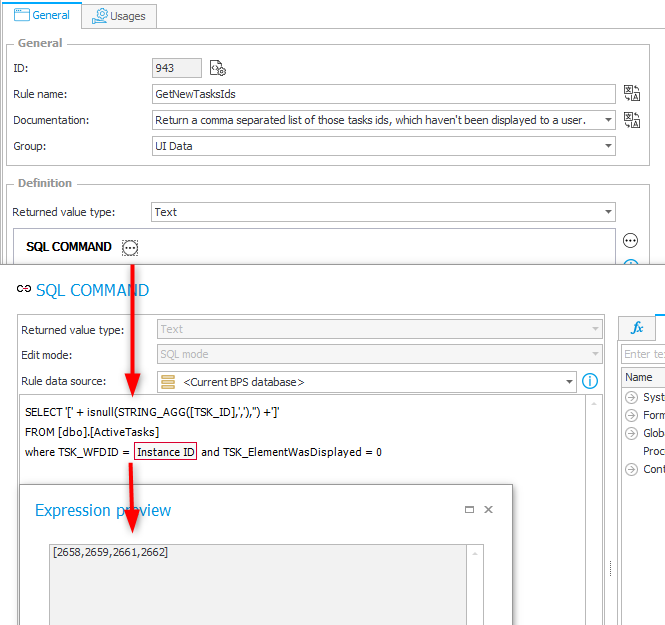
Remark: If you are using an older WEBCON BPS Version the table ActiveTasks may not exist in your database. Unfortunately, I don’t remember the version in which the tasks table was split into active tasks and history tasks.
Remark: The function STRING_AGG was added to SQL Server 2017. The compatibility level of your database must be at least 140 to use it.
Support call recipients
This rule returns the recipients of the message. The provided rule will return the recipients in the following priority:
- Process supervisor
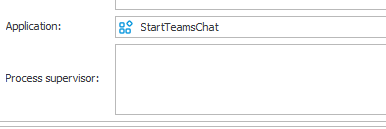
- Custom application supervisor or the BPS user
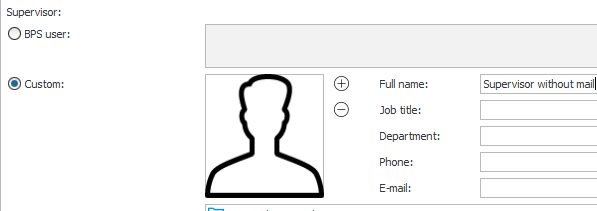
- The fallback support team.
I’ve created the following global business rule with the provided SQL command.
Rule name: GetSupportCallRecipients
Description: Returns either: Process supervisor, application supervisor or default support team.
select isnull(ISNULL(ProcessSupervisor,ApplicationSupervisor),Fallback) as Recipients
from
( select
(
select case when DEF_Supervisor = '' then null else dbo.ClearWFElemId(DEF_Supervisor) end
from WFDefinitions where DEF_ID = {DEF_ID}
) ProcessSupervisor
,(
select
case when APP_IsCustomSupervisor = 1 then (case when APP_CustomSupervisorMail = '' then null else APP_CustomSupervisorMail end)
else (case when APP_Supervisor = '' then null else dbo.ClearWFElemId(APP_Supervisor) end)
end
from WFApplications where APP_ID = {APP_ID}
) ApplicationSupervisor
, 'support1@example.com;support2@example.com' Fallback
) support
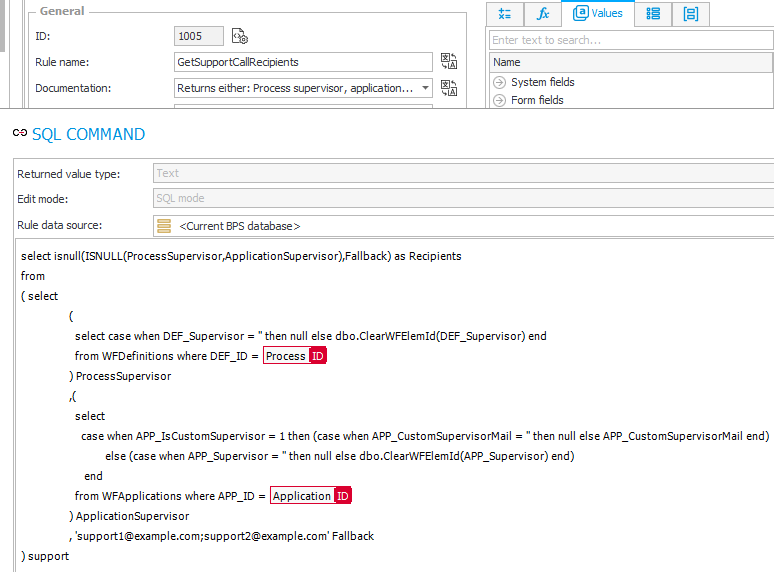
Group members
A prerequisite for displaying the users of a group on mouse over is, that we return the users. We will be using a global business rule for this, which will return all groups and their members which have an active task. If there’s no task for a group the business rule will return an empty.
Rule name: GetUsersOfGroupTask
Description:
Return a JSON array with an object of type
[
{
"GroupId": "dyz@bps.local",
"TaskId": 2659,
"Users": [
{
"Id": "user@example.com",
"Id": "Some one"
}
]
}
]
select isnull((
select TSK_ID as TaskId, groups.COS_BpsID as GroupId,
(select users.COS_BpsID as Id, users.COS_Displayname as Name
from CacheOrganizationStructure users
join CacheOrganizationStructureGroupRelations on users.COS_ID = COSGR_UserID
where COSGR_GroupID = groups.COS_ID
for json path) as Users
from CacheOrganizationStructure groups join ActiveTasks on
TSK_WFDID = {WFD_ID} and groups.COS_BpsID = TSK_User
and TSK_ToGroup = 1 and TSK_IsDeleted = 0
for json path
),'[]') as Result
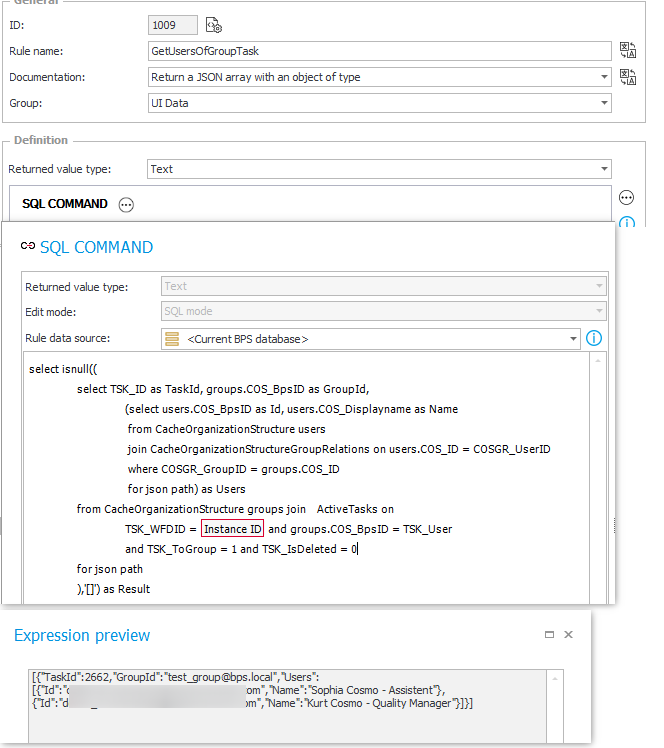
Remark: If you are using an older WEBCON BPS Version the table ActiveTasks may not exist in your database. Unfortunately, I don’t remember the version in which the tasks table was split into active tasks and history tasks.
Global form rule
You can download the JS for this form rule from the repository and paste it to the new form rule. Don’t forget to switch the type to JavaScript mode.
Rule name: InfoPanelDetailsModification
Edit mode: JavaScript mode
Description:
Contains different functions which need to be activated by setting the respective property via an HTML field:
- Custom user icon for tasks, which haven't been displayed
- Start Teams chat with assigned users
- Display members of a group to which a task is assigned
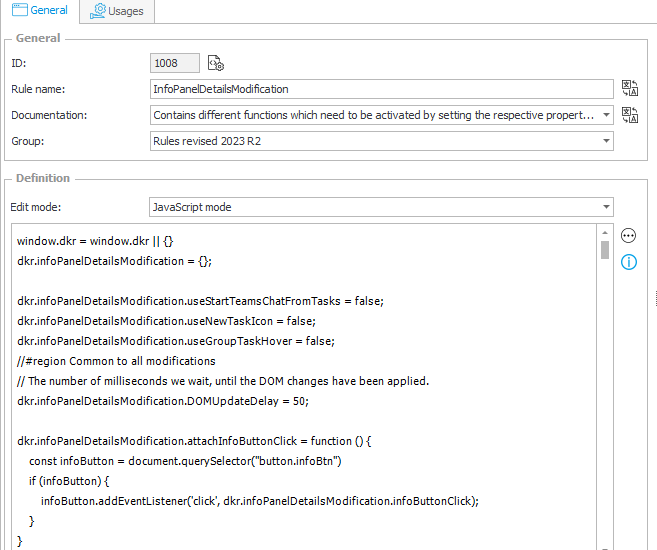
HTML field
The form rule we created here requires the common function/utilities form rule. If this is not yet available please create it before you continue.
If you have already a GlobalRules HTML field, you could add the invocation of the InfoPanelDetailsModification to it, after the common functions has been invoked. Otherwise, you need to create a new HTML field.
The provided code shows all settings for all features.
<script>
InvokeRule(#{BRUX:714:ID}#);
InvokeRule(#{BRUX:1008:ID}#);
dkr.infoPanelDetailsModification.useNewTaskIcon = true;
dkr.infoPanelDetailsModification.changeUserIconForNewTasks.taskIds = [#{BRD:943}#]
dkr.infoPanelDetailsModification.useStartTeamsChatFromTasks = true;
dkr.infoPanelDetailsModification.addTeamsChatToTasks.useWebApp = #{ISMOBILE}#;
dkr.infoPanelDetailsModification.addTeamsChatToTasks.addUrlToMessage = true;
dkr.infoPanelDetailsModification.addTeamsChatToTasks.message = 'Question regarding #{WFD_Signature}# ';
dkr.infoPanelDetailsModification.useGroupTaskHover = true;
dkr.infoPanelDetailsModification.groupTaskHover.groupMembers = #{BRD:1009}#;
dkr.infoPanelDetailsModification.init();
</script>
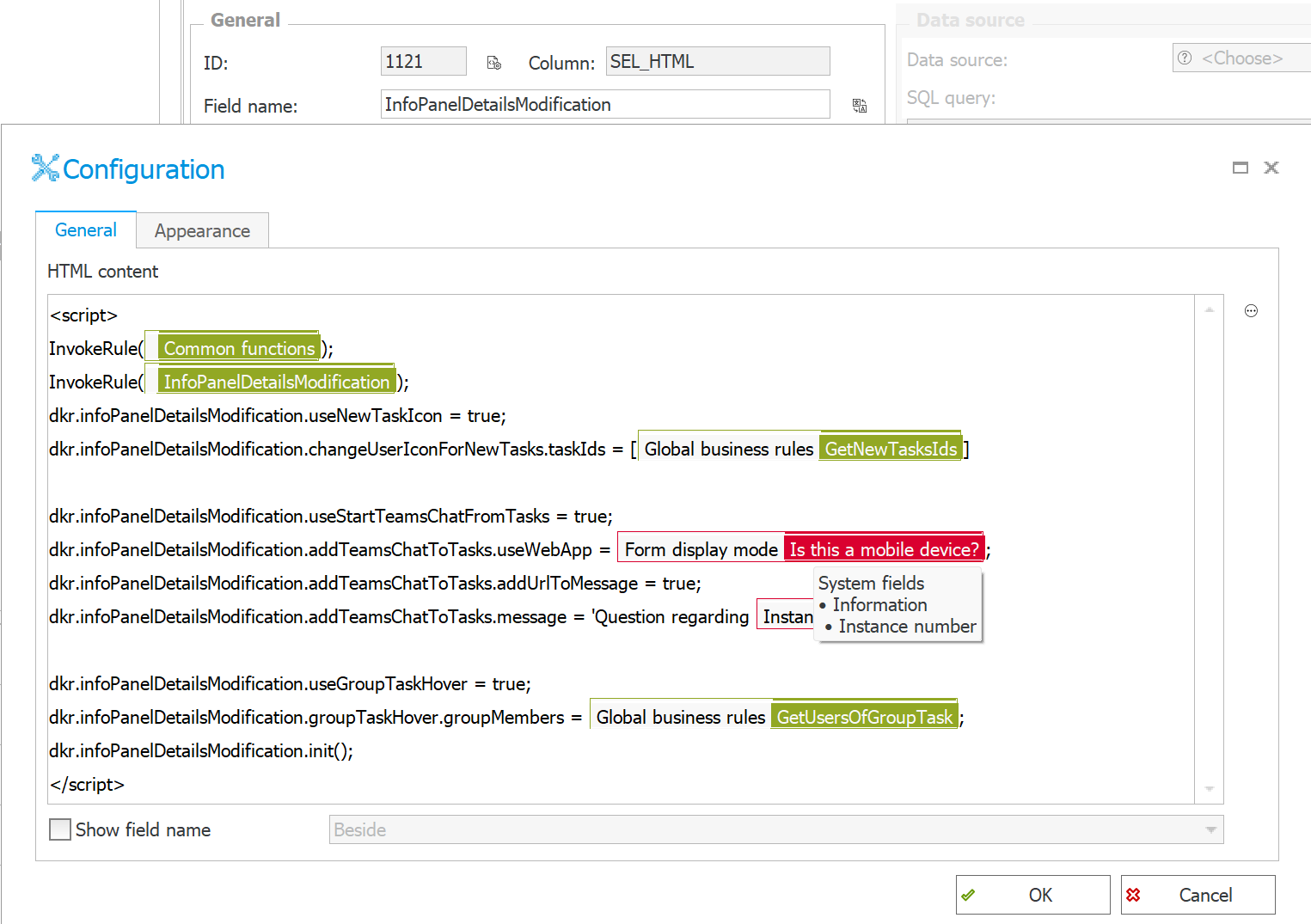
If you are only interested in one of the features, for example displaying the members of the groups, it may look like this instead.
<script>
InvokeRule(#{BRUX:714:ID}#);
InvokeRule(#{BRUX:1008:ID}#);
dkr.infoPanelDetailsModification.useGroupTaskHover = true;
dkr.infoPanelDetailsModification.groupTaskHover.groupMembers = #{BRD:1009}#;
dkr.infoPanelDetailsModification.init();
</script>
JavaScript properties explanation
Custom user icon for new tasks
- dkr.infoPanelDetailsModification.useNewTaskIcon
Defines whether the task icon will be changed, for those tasks, which haven’t been viewed by a user. If this is not set, the other property will be ignored. - dkr.infoPanelDetailsModification.changeUserIconForNewTasks.taskIds
IfuseNewTaskIconis true, it’s required to set this property. It expects an array of those task ids which have not been viewed. This is returned by the business rule.

You can also change the icon in the JavaScript of the form rule:
dkr.infoPanelDetailsModification.changeUserIconForNewTasks.newTaskIcon = "ms-Icon--D365TalentInsight"
Start teams chat with assigned users
- dkr.infoPanelDetailsModification.useStartTeamsChatFromTasks
This defines whether the Teams link will be added. If this is not set, you don’t need to set the other properties. - dkr.infoPanelDetailsModification.addTeamsChatToTasks.message = null; Message which should be passed to teams. This value will be encoded.
- dkr.infoPanelDetailsModification.addTeamsChatToTasks.addUrlToMessage = false; Will add the current URL to the message, even if the message is null.
-
dkr.infoPanelDetailsModification.addTeamsChatToTasks.useWebApp = false; If true, the msteams protocol won’t be used this will open a new tab in the browser. This will allow the user to select whether the desktop app or the web app should be used.
A custom message with which the new chat should be started. See Starting the chat with a message for the limitations.
I have not come up with a good solution to prevent syntax errors, when you are using fields which may contain the character in which you wrapped the text.
For example, I’m using single quotes here
dkr.addTeamsChatToTasks.message = '#{WFD_Signature}# #{992}#'
If the field also contains a single quote, a syntax error will be thrown:
dkr.addTeamsChatToTasks.message = 'Some signature I'm a text with a single quote'
You can use one of the following options to mark a text in JavaScript
'Text'"Text"`Text`
Show group members on hover
Here’s a short explanation of the available properties:
- dkr.infoPanelDetailsModification.useGroupTaskHover
This defines whether the hover effect should for groups should be added. If this is not set, you don’t need to set the other property. - dkr.infoPanelDetailsModification.groupTaskHover.groupMembers
You need to assign the result of the group members business rule.
Global css
The styling of the group hover is handled via the global CSS. This will allow you to modify it for your dark/light themes.
The different styling is achieved by specifying the GUID of the theme. The easiest way is to open the developer tools and take a look at the class attribute oif the body. You will notice that this value corresponds with the value in the CSS:

.dkr-group-hover-info {
position: absolute;
position-area:y-start;
padding: 5px;
z-index: 1000;
width: 100%;
}
body.theme-860305cd-602f-42c4-9999-e1825639c59c {
& .dkr-group-hover-info {
background-color: rgb(255, 255, 255);
border: 1px solid rgb(204, 204, 204);
}
}
body.theme-a24dcfc2-2b14-4de8-8af3-7952a0a2cf61 {
& .dkr-group-hover-info {
background-color: rgb(40, 40, 40);
border: 1px solid rgb(219, 220, 224);
}
}
GitHub Copilot
I have yet to make extensive use of GitHub Copilot and I’m still in the learning curve to really make use of it, but so far, I’m positively surprised how my request are interpreted and the generated code.
This is one of the successful examples. I have taken an existing function, which I wanted to modify for “displaying the group members when hovering above the group name”. I marked this function, the data structure, and GitHub Copilot did make a a correct code suggestion. As I already mentioned I was really surprised by it.
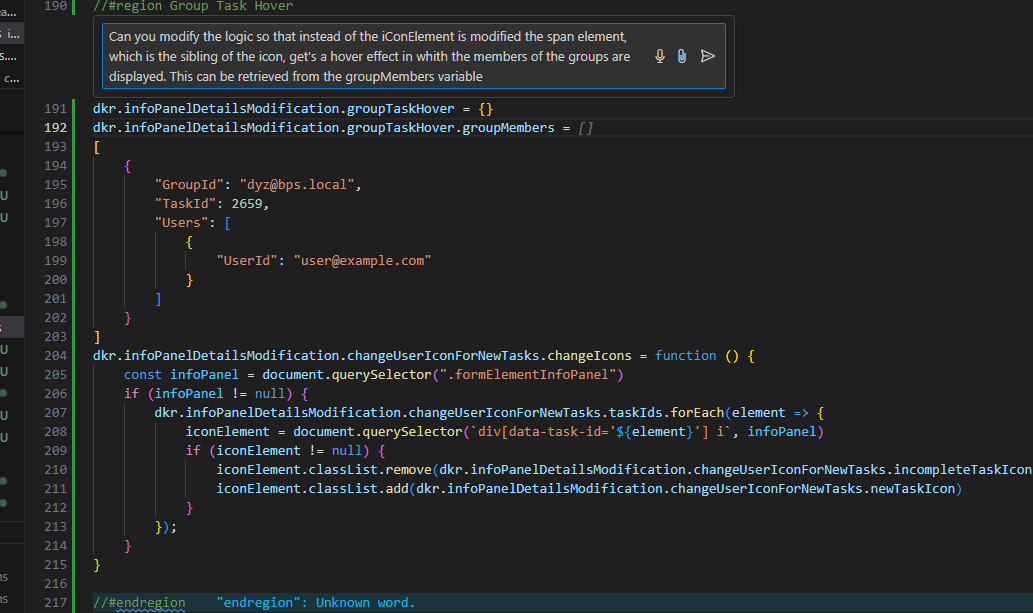
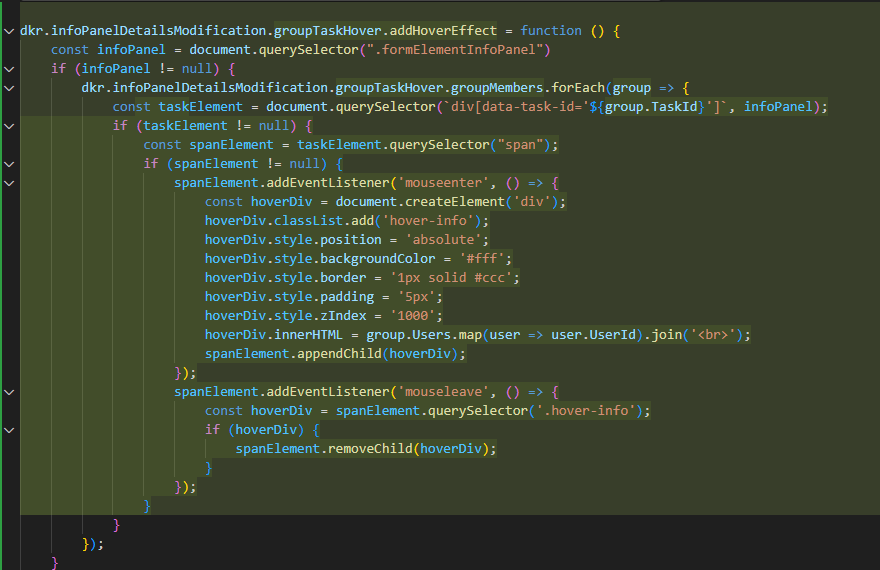
Download
You can find the full and a minified JS version here.
If you are interested in the fact, that there’s a minified version at all, you can take a look at the post Bandwidth usage.
Comments